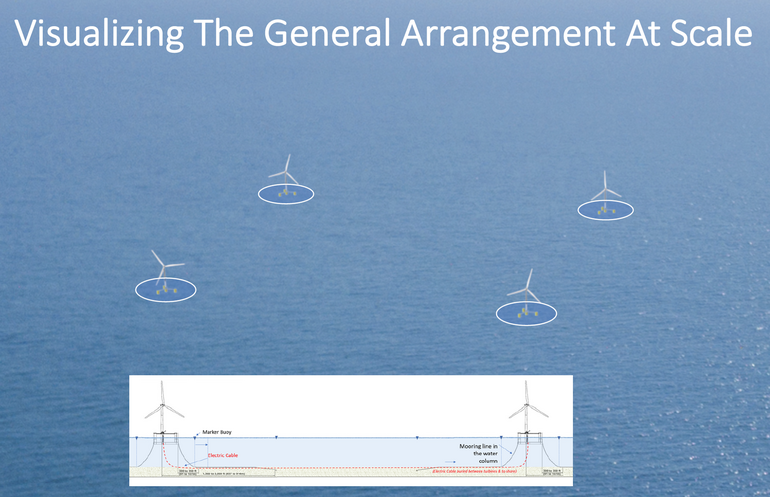
Maine joins national offshore wind research consortium
 Courtesy / Diamond Offshore Wind LLC
Seen here is a basic rendering of an offshore wind research array proposed in the Gulf of Maine.
Courtesy / Diamond Offshore Wind LLC
Seen here is a basic rendering of an offshore wind research array proposed in the Gulf of Maine.
Maine has joined the National Offshore Wind Research and Development Consortium, a public-private partnership that could expand the state's access to research and resources for its offshore wind program.
“Through the consortium, Maine has the opportunity to learn and advance technologies alongside a variety of others to guide offshore wind energy in the Gulf of Maine,” Dan Burgess, director of the Governor’s Energy Office, said in a news release Thursday. “Access to more knowledge, data and research from around the country will inform our approach to offshore wind and benefit Maine’s people, communities and economy.”
Maine’s membership in the consortium includes the Governor’s Energy Office and the University of Maine, a center of technology and innovation in floating offshore wind. The nonprofit consortium, established in 2018, works to advance offshore wind technology in the United States through cost-effective and responsible development to maximize economic benefits.
“The University of Maine is very pleased to support the state as it strengthens important research ties nationally and internationally on floating offshore wind,” said Habib Dagher, executive director of Advanced Structures and Composite Center at the University of Maine.
The center is conducting a project with the consortium on synthetic mooring systems, considered an example of a collaboration designed to help reduce impact on fisheries.

“We look forward to more such collaborations through this new membership,” he added.
Funding for the consortium includes $18.5 million from the U.S. Department of Energy provided through and matched by the New York State Energy Research and Development Authority, as well as contributions from the states of Virginia, Massachusetts and Maryland.
The Governor’s Energy Office is leading the development of a research array of up to 12 turbines covering up to 16 square miles in a location still to be selected along southern Maine coast.
Maine’s participation in the consortium is expected to add an opportunity for collaboration with other national research efforts, said Carrie Cullen Hitt, the consortium’s executive director.
A recent report by the Governor’s Energy Office found that offshore wind energy has the long-term potential to meet Maine’s nation-leading renewable energy targets, a critical component in the state’s efforts to fight climate change and spur economic growth through developing clean energy.
In 2020, the Governor’s Energy Office received a $2.16 million grant from the U.S. Economic Development Agency to manage a multi-year planning process to develop a “roadmap” for the offshore wind industry in Maine. This process is expected to begin this spring.
As part of the roadmap, the governor announced in November that Maine would pursue the country’s first research lease for a floating offshore wind array, to be located in federal waters of the Gulf of Maine. With some of the highest sustained wind speeds in the world, the Gulf of Maine is viewed a likely area to be targeted for offshore wind energy.
Pursuing the research array as a first step toward commercialization is considered a proactive approach by the state in order to work with stakeholders to determine the direction of offshore wind energy in the federal waters of the Gulf of Maine.
Gov. Janet Mills has announced her intention to submit legislation calling for a 10-year moratorium on new offshore wind projects in state-managed waters, which extend 3 miles from shore, and where the majority of Maine’s commercial fishing takes place.
The Governor’s Energy Office has scheduled a series of upcoming virtual work sessions about the research array project. For details, click here.
In addition to the consortium, Maine has forged regional and global partnerships developing offshore wind power. The state is a member of the Gulf of Maine task force assembled by the federal Bureau of Ocean Energy Management, along with New Hampshire and Massachusetts.
In late 2020, Maine announced it had signed a memorandum of understanding with the United Kingdom, which calls for collaborative research and knowledge sharing about responsible offshore wind development between Maine and the U.K.
In January, a coalition of fishing communities sent a letter to Mills expressing concern about the proposed offshore research array in the Gulf of Maine.
New England Aqua Ventus LLC, a joint venture between Diamond Offshore Wind and RWE Renewables, is developing the University of Maine’s offshore floating wind technology prototype, called the VolturnUS, as a demonstration project to evaluate floating technology, monitor environmental factors and develop best practices for offshore wind to coexist with traditional marine activities in the Gulf of Maine.













0 Comments